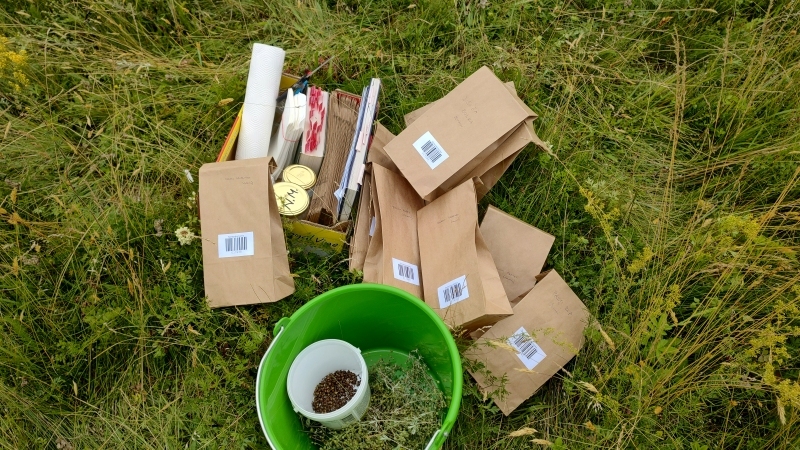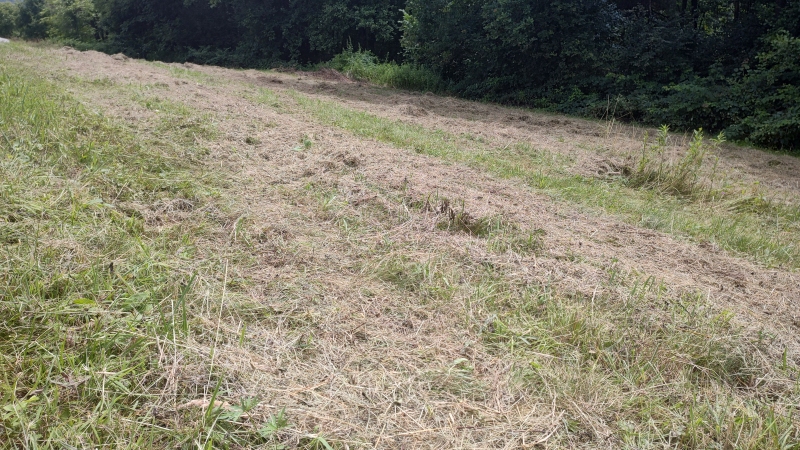Active Summer for the LIFE FOR SEEDS Project in Goričko
![]() M. Matjašec, 10. 7. 2024
M. Matjašec, 10. 7. 2024
During the summer months, work on the project in Goričko is in full swing. The seeds have ripened again, and its time to collect them for the seed bank, harvest seed mixtures for meadow restoration, and renew with so-called green mulch. We have signed one-year contracts with meadow owners involved in the projects activities, committing them to slightly different management practices. In practice, this means either slightly delayed mowing, our collection and removal, or leaving a larger uncut strip.
Seeds for the Seed Bank
The meadows intended for seed collection for the seed bank are beautiful, colourful, and true treasures of plants (including wild orchids) and animals. These are the most diverse grasslands, with up to 80 different species per square metermeter (such as green-winged orchid, burnt orchid, tall hawkweed, dopford pink, hairy cat’s-ear, quaking grass, furroerd fescue, oat grass, and more). Of course, we do not only collect seeds in May and June but also throughout the vegetation period, as not all plants seed simultaneously. For instance, in July, we will collect various carnations, common plantain, centaury, and others. The goal is to collect at least 24 batches from one meadow, meaning seeds of at least 24 species of meadow plants.

Seed batches M. Matjašec
Restoration of Dry Meadows with Green Mulch
As part of the LIFE FOR SEEDS project, we have restored dry meadows with green mulch for the last time this year. To remind, green mulch is freshly mown grass from a species-rich meadow transported to a species-poorer meadow. The green biomass was transported using a self-loading trailer with densely placed knives for cutting the grass. The restoration was carried out only in specific parts of the meadow for comparison with the seed mixture restoration. This means that only half of the meadow was allocated to green mulch. We tried to spread the green biomass as thinly as possible during the scattering to prevent it from rotting. Since it was very hot during the application, the scattered biomass dried quickly, making our work easier as it was sometimes necessary to spread the biomass with a tedder. The warm weather accelerated the ripening of the green plants seeds, which we hope will germinate. We transported green meadow biomass from 7 hectares to 3.5 hectares of land.

Green mulch in Dolenci M. Matjašec
Restoration of Non-Priority Meadows Type HT 6510 and HT 6410
We approached the selection of the restoration method for non-priority meadows experientially, as we believe that the seed mixture method, although more physically demanding, is more successful compared to the green mulch method after two years of dry meadow restoration. This time too, we were harvesting in to time periods. The first part is behind us, and we have obtained over 20 kg of fresh, green seed mixture. The second part of harvesting is still ahead, expected at the end of August, depending on the weather. The seed mixture is currently drying in the castle rooms of Grad Castle and will soon be dried. This year, we started coarse sieving of the seed mixture in the field, which proved effective as it reduced the material to be transported and left some seed mixture in the meadow.








